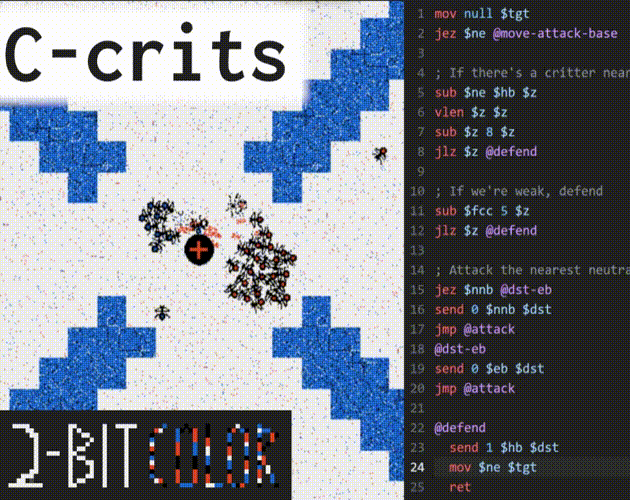Procedural Textures with Hash Functions
and Hash Playground
I'm the sort of person who gets very excited when simple rules create complex behaviour. The other day, I needed a simple hash function that maps $(x, y)$ coordinates to a colour, and found a straightforward equation that ended up being astoundingly rich. Hence this post; to talk about and play with this function.
TL;DR: The boolean predicate $(c_x \, x + c_y \, y + c_{xy} \, x \, y + c_{x^2} \, x^2 + c_{y^2} \, y^2)$ $\mathrm{mod} \, m < \tau \, m$, is richly varied and beautiful.
For example, varying $c_{xy}$ with the other parameters fixed:
For the rest of this post, we'll try to unpick the function. If you'd prefer to play with it yourself, check out the hash playground.
The idea
I was trying to make a game that obeyed a 2-bit colour palette. With a strict interpretation of the rules, this means no interpolation or antialiasing — the pixels onscreen should only be one of 4 colours. So I needed textures that could align perfectly to the screen. The idea I ran with was to hash the (x, y) screen-space pixel coordinates, use this value to choose a colour.
It turns out that this works fine, as long as the camera and viewports are fixed, and a simple hash function can be remarkably varied and interesting:
$$(c_x \, x + c_y \, y + c_{xy} \, x \, y + c_{x^2} \, x^2 + c_{y^2} \, y^2) \,\mathrm{mod} \, m < \tau \, m$$
In Python, for example (or see notebook):
c_x, c_y, c_xy, c_xx, c_yy = 1, 1, 0, 1, 1
m, t, w, h = 64, 0.5, 128, 128
x = np.arange(w)[:, None]
y = np.arange(h)[None, :]
h = (c_x*x + c_y*y + c_xy*x*y + c_xx*x**2 + c_yy*y**2) % m < t*m
display(PIL.Image.fromarray(h))A little understanding
Let's try to build up the maths to understand some of the structure behind these patterns. We'll call the expression between $()$ the body. Note that everything in this section uses a canvas width of $128$, divisor $m\!=\!64$ and threshold $\tau\!=\!0.5$.
What if our body is just $(x)$? The hash won't depend on $y$ and should be $\mathrm{true}$ for $x \!<\! 32$ and $\mathrm{false}$ for $32 \!\leq\! x \!<\! 64$. It should repeat twice over our canvas width of $128$:
How about $(x^2)$? I expected to see a twice-repeating pattern again, but I was wrong — we get $4$ copies:
I.e. the pattern seems to repeat after $m/2$ not $m$. Let's see what happens if we add $m/2$ to $x$:
$$ \begin{align} &(x + m/2)^2 \,\mathrm{mod}\, m \\ &= (x^2 + m\,x + m^2/4) \,\mathrm{mod}\, m \\ &= x^2 \,\mathrm{mod}\, m \;\;(\textrm{if } m \textrm{ is a multiple of } 4) \\ \end{align} $$
Since the $+\, m/2$ disappears, the pattern must repeat every $m/2$ pixels rather than $m$.
To understand the pattern itself, it's like an extreme aliasing effect. Scanning left to right, first you follow a quadratic: black then blue. Then you skip over the $m$ boundary, and you have the same thing again but faster. And again even faster. Eventually, you're skipping so fast that after every other pixel you're skipping to the next multiple of $m$. Like watching a video of helicopter blades as they spin up, the pattern starts to run backwards. The frequency slows again until the next long black patch when you're skipping $\approx m$ every pixel. Then the pattern repeats.
Going 2D, $(x^2 + y^2)$. To get genuinely interesting patterns, we need to use $x$ and $y$. Since the equation of a circle is $x^2 + y^2 = \textit{const}$, circles are iso-hash lines which are clearly visible. Since the expression is built using $x^2$ and $y^2$, we get $2$ copies per $m$ in each axis, so $(2 \cdot 128/64)^2 = 16$ sets of circles in total.
Increasing the frequency, $(2 x^2 + 2 y^2)$. Unsurprisingly, doubling $c_{x^2}$ and $c_{y^2}$ doubles the frequency of the pattern, equivalent to halving $m$ from $64$ to $32$.
Cross terms, $(x\,y)$. Some of my favourite patterns come from fiddling with $c_{xy}$. Even the simple body $x\,y$ is interesting. I don't have much of an explanation, except that the iso-hash is $x\,y = \textit{const}$, producing a family of reciprocal curves $y\propto1/x$, which seems to match the black and blue lines that form a pleasing spiral.
That's all I've got for understanding; I'm sure there's much more that could be said from the maths of modular arithmetic, which is mostly beyond me.
Some favourites
Here are some personal favourites after some idle tinkering. Note the similarity in the first two equations, which produce very different patterns.
It's particularly fun to sweep the threshold $\tau$, which can be useful for effects like explosions.
Wrap up
I hope you enjoyed staring at the complexities of a simple function for a few minutes! If you haven't already, try the hash playground. Maybe you can generate a new texture for your game or print a case for a mobile phone (my next step).
See if you can spot some of these hash textures in the clip from my game-jam game below. And if you consider yourself part of the extremely limited target audience (who want to learn an assembly-like language just to play a short web game), perhaps check it out: C-crits.
Happy Hashing!
